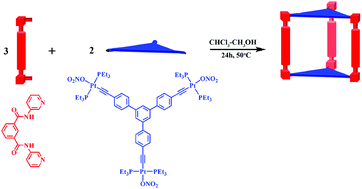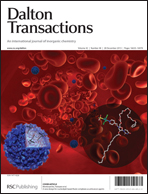PtII6 nanoscopic cages with an organometallic backbone as sensors for picric acid†
Abstract
An organometallic building block 1,3,5-tris(4-trans-Pt(PEt3)2I(ethynyl)phenyl)benzene (1) incorporating Pt-ethynyl functionality has been synthesized and characterized. [2 + 3] self-assembly of its nitrate analogue 1,3,5-tris(4-trans-Pt(PEt3)2(ONO2)(ethynyl)phenyl)benzene (2) with “clip” type bidentate donors (L1–L3) separately afforded three trigonal prismatic architectures (3a–3c), respectively. All these prisms were characterized and their shapes/sizes are predicted through geometry optimization employing molecular mechanics universal force field (MMUFF) simulation. The extended π-conjugation including the presence of Pt-ethynyl functionality makes them electron rich as well as luminescent in nature. Macrocycles 3b and 3c exhibit fluorescence quenching in solution upon addition of picric acid [PA], which is a common constituent of many explosives. Interestingly, the non-responsive nature of fluorescent intensity towards other electron-deficient nitro-aromatic explosives (NAEs) makes them promising selective sensors for PA with a detection limit predicted to be ppb level. Furthermore, solid-state quenching of fluorescent intensity of the thin film of 3b upon exposure to saturated vapor of picric acid has drawn special attention for infield applications.


 Please wait while we load your content...
Please wait while we load your content...